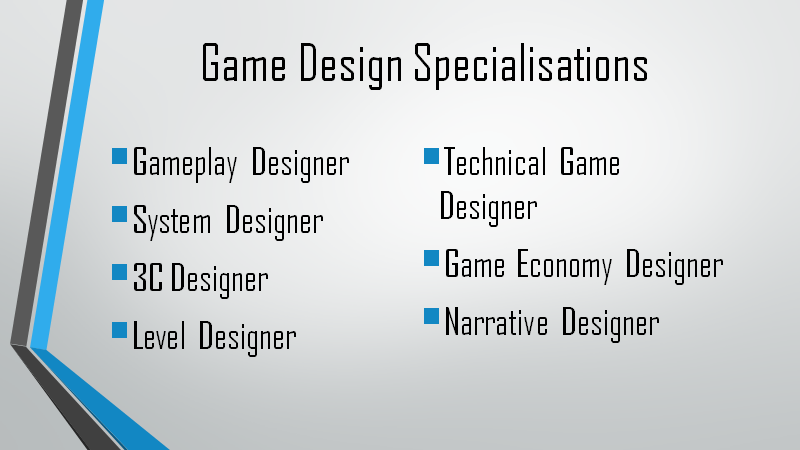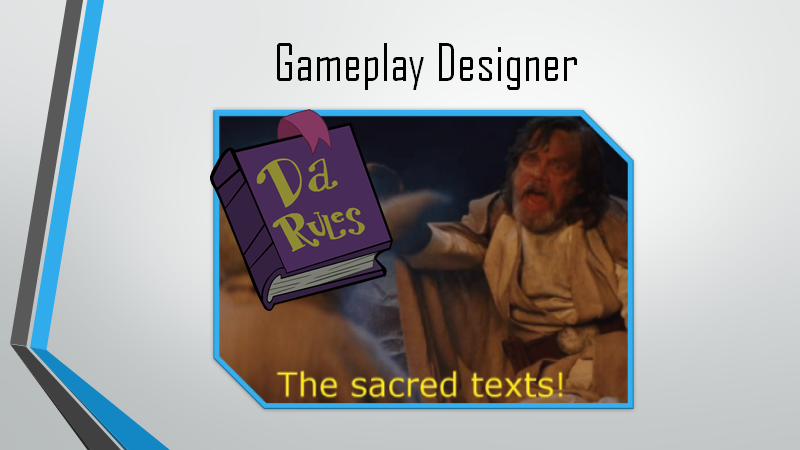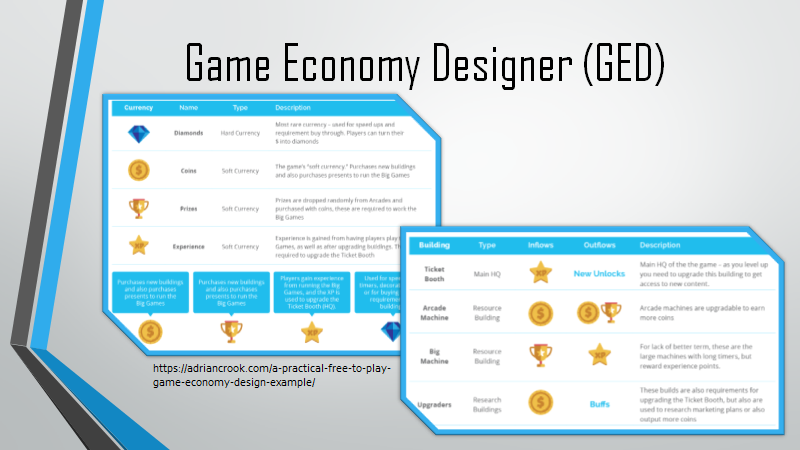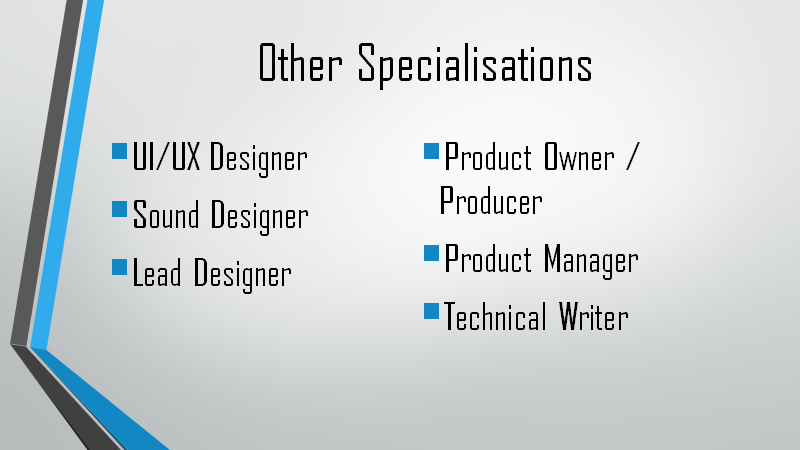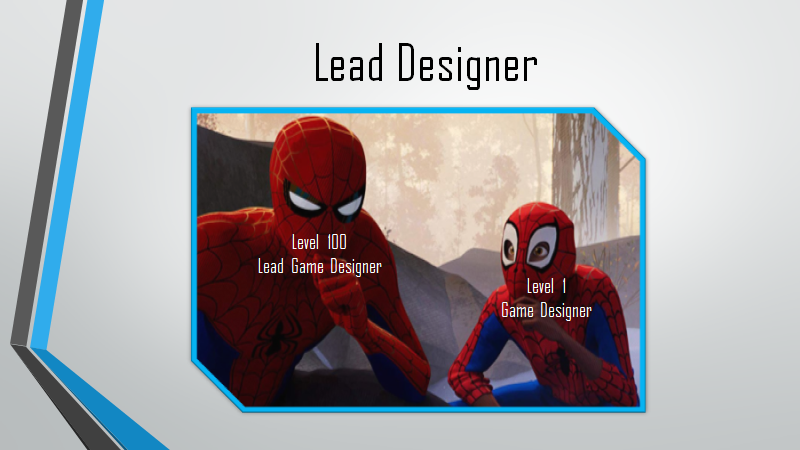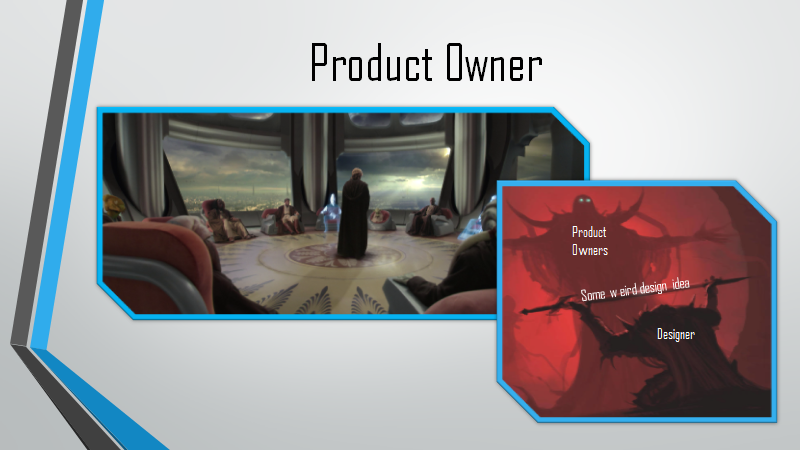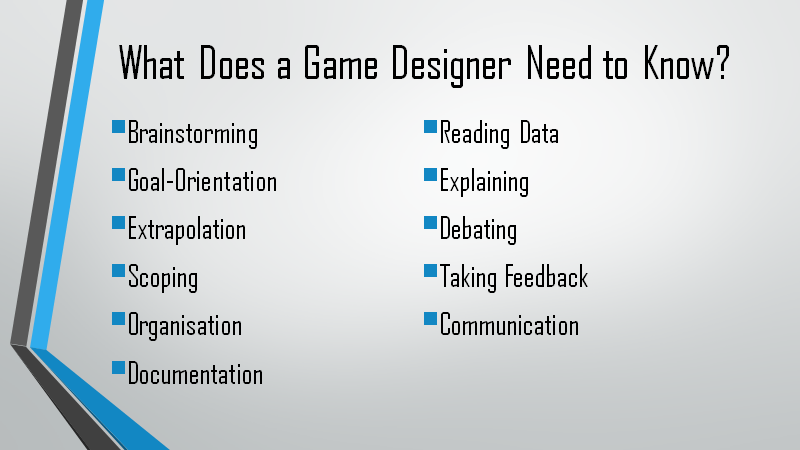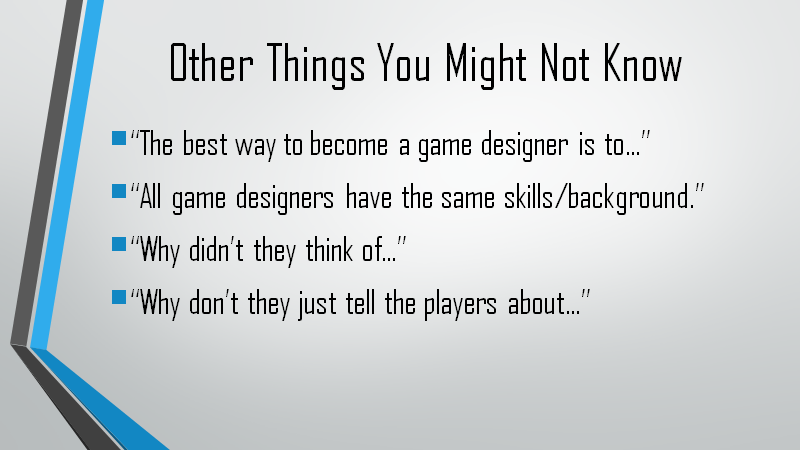I was contacted a few months back by Kurius to do a talk for their Learnathon event. I’d be talking to students about game design. I thought it was a really cool initiative, so I asked and got the go ahead from Ubisoft (I work there now by the way; it’s been so long since my last blog update that I’ve changed studios once and projects twice).
Figuring out a topic was the hard part. After all, back when I was in high school I barely even knew what game design was before I dove right into university for it. In the end, I took my own experience as the main reference for what to talk about. This is a compilation of the basics about game design. The harsh reality that it’s as much a profession as any other job. That it’s not something you can do as a lone wolf. What kind of work a game designer is actually expected to do on a day to day basis. I took all the things I learned outside of school (besides, why would I talk about what you do learn in school; you can go to school for that) and tried to cram it all into an hour and a half, with the help of a few memes because that’s how I do. This presentation you see here was the result.
As of me writing this, I’ll be presenting in about an hour, so I’m going to try and copy down my transcript and slide images quickly so that anyone that watched the presentation can find this page right after, just in case they want to read what I said instead of listen to a recording.
As for any questions, I’ll see if I can remember to put another entry about that some other time, along with my long overdue update and various other articles I’ve been meaning to post here for the last year or so.
EDIT: Now with a video of the recording, in case you want to hear me say “euh” a lot.
Alright, so let’s say for the sake of argument that you’re interested in becoming a game designer. In that case, how might this talk help you? What’s it all about?
Well, the first thing I’m going to do is crush all your dreams, obviously! Okay, not really, but I am hoping I might dispel a few myths about game designers. I know that to a lot of people, game design seems like it could be a dream job, and it absolutely can be! But it is still a job, with work, responsibilities, and challenges.
What I’d like to do today is talk about the realities of game design as a profession, so that you can see if it really is something you’d be interested in, and if so where to go from there. This is stuff I didn’t learn from a classroom, but looking back at it now, that I wish I had known about when I first started out. Hopefully you’ll find it useful!
I’ll be covering some pretty broad topics like “What is a game designer?”, “What do we do?”, “What are all the different types of game designers?” (because yes, there’s more than one), “What is the game design process?”, and also a few things you might now know about what we do and even a few suggestions to get you on your way.
So then, before we dive right into things, you might be wondering, who even is this guy, and why should I listen to him?
Hi, my name’s Justin, and I’m a game designer. I studied Interactive Multimedia and Design at Carleton University and Algonquin College in Ottawa. It’s a course that covers a whole bunch of digital media stuff like games, web, film, animation. Later on I also did a DESS (that’s a Diploma of Advanced Studies) in Game Design at the University of Montreal.
In terms of professional experience, I’ve spent about 5 years in the indie games scene, working on a bunch of games you’ve never heard of. That’s not me trying to get hipster cred by the way. Sadly it’s because most of those projects died before they ever came out. Funny thing about indie is that for every success like Minecraft or Cuphead, there are thousands of games that don’t succeed or never even see the light of day. That logo is for Forged Interactive, which is the only indie studio I was in that got far enough to have a social media presence, and unfortunately they never actually released the title I worked on with them.
Eventually though, I broke into the big leagues of mobile games. I started off doing some testing work, mostly testing levels of King games like Candy Crush and Blossom Blast. Then I was hired full time at Gameloft, first as a technical game designer and then later on as a game economy / systems designer. I was with them for about three years, until late last year.
Now I’m at Ubisoft, working on AAA titles. I started with Hyper Scape, and now I’m on this little very obscure game called Rainbow Six Siege. So you could say between indie, mobile, and AAA, I’ve got experience in all three categories of games.
Oh, and on the side I’ve also done a ton of game jams and tabletop gaming. I didn’t get paid for those, but I like to think the experience still counts.
I hope that was enough to convince you that I might actually know what I’m talking about, at least a little bit.
Okay, let’s start with the first big question. “What is a game designer?”
Now, you might have heard or even thought of some of these lines before. I’ve certainly heard variants of all of them, sometimes even from my coworkers in the industry.
These are, of course, all wrong… Kinda. Like with everything, it’s complicated. I’ll try and break these down a bit.
First off, yes, designers do come up with ideas, but we’re far from the only person on the team that does that, and it’s far from the only thing we do. It’s a bit like saying a student is “the homework guy”. There’s a bit more to being a student than just doing homework, even if sometimes it really does feel that way.
Next, that creative director comment. You probably don’t hear it said like this, but maybe at some point you’ve thought of something like “I wanna be the next Hideo Kojima, or Sid Meyer, or Shigeru Miyamoto, and make my own franchise!” A lot of aspiring game designers think like that (I’ve done it too, to be honest). It’s a common dream to be the person that creates the next big title all on their own and to be remembered as “the Metal Gear Solid guy” or “the guy who made Super Mario”.
The reality is that while creative directors can definitely be a big influence on a game, saying it’s their creation oversimplifies things. Games are rarely a one-person project, and in reality a creative director is more like a navigator. They determine a direction of where they want the game to go, and they try to make sure that everyone works towards going in that direction. They aren’t usually the one that figures out the how, and that’s a huge part of what makes games what they are. Behind every great creative director, there’s an equally great if not greater team backing them up.
So in that case, surely that last point is true, right? That we tell everyone else what to do? Well, sadly that’s wrong too. Believe me, I’d love to be able to just decide things and have everyone follow my commands. It would make my life so much easier! But no, sooner or later a programmer or artist or director will come around and slap you with the cold hard fish of reality, and trust me, that thing can sting!
Most of the time, game design is more like a negotiation. On the one side, we need to talk to the technical people like programmers and artists to see if our idea can be made and what it’ll take to make it work. Then on the other we need to talk to producers and directors to convince them that our ideas are worth trying to make work. Unless you succeed on both fronts, you’re going to have to go back to the drawing board.
Alright then, so what actually is a game designer then?
They are a miserable little pile of solutions. Boy I hope some of you get that reference because it’s old, even by my standards!
What I mean is, at our core we game designers are problem solvers. Our job is to find or take a “problem”, figure out the best possible solution for it that everyone on the team can agree on, and then help everyone to understand, build, and promote that solution.
For the record when I say “problem”, that can cover a wide variety of things. For example, “I want a class-based competitive first person shooter that is unique from other games in this category”, “I want the movement in this game to be more fun”, or “I want a feature that will make people want to spend more money in the game” would all be “problems” that a game designer might be tasked with solving.
Another comparison I like to use to help people understand is that a game designer is kind of like an architect. They don’t decide where the building will be or what it will be used for, and they don’t build or paint it themselves. Their job is to write up the plans everyone else is going to follow, and make sure that whatever they drew isn’t going to collapse.
So you may have noticed that my definition of a game designer is really vague. There’s a lot of ways to solve a problem after all. It’s almost like calling someone an adventurer. If you’ve played an RPG or watched an anime in the last five years, you know that there’s no universal rule for what an adventurer is or what they can do. Rogues, Wizards, and Fighters can all be types of adventurers, but you’d hardly say they’re the same thing. If you’ve played these types of games, you also know that it’s usually better to pick one or two classes and stick with them, rather than dip a tiny bit into twenty different classes. The same is true for game designers.
There are many different specialisations in game design, each of which focuses on different aspects of a game. While it might be a while still before you need to pick a specialisation for yourself, it’s not a bad idea to keep them in the back of your mind as you build up your skills, as this can be a big help towards getting you that unique edge over other people looking to get into the industry. That’s because the sad truth of the matter is that generalist game designers have a much harder time getting a job, at least in the bigger studios.
I’m actually a good example of this. At first, I had a lot of trouble finding a job as a game designer. But then I made one little change and literally within a couple months I got my first job offer from Gameloft. That change was me swapping my portfolio title to from “Game Designer” to “Technical Game Designer”. The crazy thing is that I didn’t even change my skill list! I just changed the label I used to highlight things that I could do that other generalist “game designers” couldn’t. Namely, that I had some decent programming ability.
Let’s break down some of the specialisations in game design. Please bear in mind that this isn’t a complete list. It’s also not universal. A lot of studios use different names for these roles, or there’ll be hybrid roles that are a mix of these. There aren’t really any standards in the industry as far as these go. This is because the industry takes great pleasure in frustrating you and themselves. Still, it should give you a rough idea of the available specialities.
Gameplay designers are probably what most of you think of when you think of a game designer. They’re the people that come up with the rules for how a game is played. That’s stuff like win and lose conditions, the gameplay mechanics and inputs, etc. Their focus is on what’s called the “Action Phase” of the game, which is the part of a game where the action happens.
Systems designers are a slightly more obscure type of designer by comparison, but also essential to how a game works. Like gameplay designers, they also define the rules of the game, but their focus is on how everything goes together. For example, in an RPG a gameplay designer might handle combat, but a systems designer would figure out stuff like levelling, items, and how those things all link with each other. They’re kind of like “big picture” designers that look at how all the gears fit to make the engine run.
These whiteboards are actually snapshots of some of my previous work as a systems designer. Sometimes, things can look really messy before they start to make sense...
3C designers are responsible for the 3Cs. That stands for Character, Controls, and Camera. Basically, they are the ones that handle the player character and how they move and interact with the world. They don’t often get as much recognition as other designers, but their impact is critical to making a game “feel” good, which is a lot harder than it sounds. 3Cs is why parkour in Assassin’s Creed and Mirror’s Edge feel completely different, or why you’d never compare Doom and Call of Duty, even though they’re both technically FPS games.
Level designers are probably one of the other most famous types of designers. If you’ve played games, you probably know what a level is, and if you know that, you probably have a good idea of what a level designer does. They’re the ones that figure out the layout of the maps and what will be inside of them. These designers tend to be more artistic or visually-minded, and will usually work closely with the art team, but they also need a good sense of space and pacing to go along with that aesthetic.
Technical game designers are like a bridge between designers and programmers. They’re usually responsible for backend stuff like creating tools for other designers or figuring out how the game’s data is managed. Having a good understanding of either programming or database management is very useful for these types of designers. It’s also one of the easier designer roles to get as an entry-level position because it will often involve a lot of grunt work and isn’t very creative or glamorous. For example if you’ve played a game with a lot of different items with unique stats, a TGD was probably the one responsible for listing all of them out in a table. Despite its reputation, technical game designer is a very important role, and it can help you learn a lot about how games are made.
Game economy designers are the people that deal with numbers and balancing. That can include scoring, damage, health, how often you get and use resources… Anything with a number, really. If you’re a fan of resource management games or making spreadsheets, then this role might be for you! It’s a tough and sometimes tedious job, but it’s also one that’s almost always in high demand.
The GED role often gets merged with systems design (like I was at Gameloft), but in bigger studios they’ll usually be their own specialisation. Also, sometimes GEDs are instead focused on the monetisation side of things. In those cases, their responsibilities shift a bit more into subjects like when and where to try and sell you stuff and how much stuff you get for your money. In those cases, they’re the ones that handle how things like battle passes and loot boxes. I know some of you might hate them already for that, but they’re in the difficult position of making sure that the game they’re working on makes a profit. If they don’t succeed, then the game will probably get killed. They have the unenviable task of designing features that make enough money to keep the higher ups happy while also being balanced and fun, and that’s not easy to do!
Finally, we have narrative designers. Their role is a little more complex than just writing the story. Rather, they have to come up with how that story is delivered to the player and how the story will interact with the player. They are the person that brings the world of the game to life. Any writer can throw a wall of pretty text at you, but a good narrative designer will make sure that you experience the story.
If you’ve played a narrative heavy game like Undertale, Doki-Doki Literature Club, Spec Ops the Line, or Mass Effect, you know what I mean when I say that narrative design can go a lot deeper than just writing. Those are all games that make the narrative design a fundamental part of their identity.
Besides this list, there are some other roles worth mentioning within the design sphere. These aren’t game designers per se, but they do either work very closely with them, or have very similar responsibilities or job descriptions.
UI and UX designers handle how the game looks and feels. While these two roles usually end up focusing on the menus and HUDs, their job can extend through the entire game, especially for UX.
You might have heard these terms before, and very often they get used interchangeably. There is however a difference. UI (user interface) is more focused on the appearance of things. They handle things like colour, fonts, visual effects, and the like. UX (user experience) meanwhile focuses on flow and feel. They might be responsible for what menus lead to where and how things behave when you interact with them. UI is more of an art discipline, while UX is closer to design, but both usually have their own independent department in bigger studios.
Sound design is a lot like UX in that it’s a design role that is often separated from other designers. Some of you might think that a sound designer is the person that makes the music and sound effects for the game, but usually you’ll get a composer and foley artists to handle those things. A sound designer’s job is more about how and when those sounds show up in the game. In a lot of ways, their work is similar to that of an animator, since a lot of it is about defining the moments and actions that trigger certain sounds.
One example of a more creative sound design mechanic can be found in Nier Automata’s hacking minigame. The fight music seamlessly transitions between the normal version and the 8-bit version whenever you start a hack. There’s some cool tech that makes that happen, and that’s the sort of thing a sound designer might be involved in coming up with.
Lead designer is kind of a weird title. It’s not really a type of designer in and of itself, but rather an indication of seniority or authority for a designer. In other words, a lead designer is usually the designer on a team with the most experience, and will oversee the other designers to make sure their work is good or fits together with the work of other designers on the team. Depending on the project, they can be more like a manager, and sometimes, they’re more like that one person that presents the group project on behalf of the rest of the team.
Product managers (also called producers depending on the studio) are the people that handle most of the resources on the team, very much like what a producer does in the film industry. They’re the ones that make the budgets, task lists, and schedules. They figure out who the team needs to talk to to get things done, plan meetings… As you can imagine, this is very much a managerial role, but they work hand in hand with designers to push ideas and make sure that the team has everything they need to actually turn those ideas into a game. In a way, a lot of their process is very similar to how a designer works. They just think about the people and the process, instead of product.
Product owners are people a step above designers when it comes to the hierarchy of decision making for a game. You usually have several of them on a game, and it’s a title that goes on top of some other leadership role. Creative directors, lead designers, heads of departments, and in some cases even the studio head can all be product owners. They’re usually the ones that define the problem that the designer must offer solutions for, and they’ll be the judge for whether the designer is on the right track or not with their solution. They are the council that will decide your fate.
In other words, as a designer, product owners are the people you need to convince that your designs are worth actually building. This can get extra fun if you have multiple product owners that represent different interests, and you have to find something that satisfies all of them. It can become quite a game of politics!
Last but not least, technical writers. They’re the people who keep all the project’s documentation up to date, especially when the designers aren’t doing it themselves (which is often; a lot of designers hate writing their own documentation, even if they should be doing it). Usually this means they’ll have to talk to designers and programmers to get all the details on how absolutely everything works, and then write it all down somewhere so that everyone else can read and understand it. They’re the people that make user guides and instruction manuals for the devs. By the way if you’re wondering where it all gets stored, most of the big studios use internal sites that are basically like private wikis. Confluence is a pretty commonly used tool for our documentation, for example.
Technical writing involves a lot of the same responsibilities as a game designer. The only difference really is that they listen and record, but don’t present the ideas themselves. It’s a great job to start with if you want a taste of what the more technical aspects of game design, right up there with game tester. Tech writers are also usually the people who are the most knowledgeable about how a game works. Turns out when your job is to collect and explain information about a subject, you can get a pretty good grasp of that subject.
That was a lot of different roles, and they do cover a lot of different aspects of making a game, but there are some things that all game designers do have in common. If you’re interested in game design in general, there are a few things you ought to know. Here’s the most critical stuff that every designer needs to be able to do.
Brainstorming: You’ll have to come up with a whole lot of different ideas
Goal-Orientation: Having many ideas is great, but do the ideas you have actually satisfy the objectives you’re trying to achieve?
Extrapolation: That means fleshing out an idea. What you thought of might sound cool, but how would it work?
Scoping: You have to be realistic about what you can do with the time and resources you have; many games have failed simply because they were too ambitious!
Organisation: At some point you’re going to have to put all of your thoughts together in a way that makes sense, and that takes some serious organisational skills.
Documentation: As a designer you’ll spend more time in programs like Word, Excel, and Powerpoint than in the game engine
Reading Data: These days nearly every game has analytics, and part of a designer’s job is to read all those graphs and tables and understand what they mean, so don’t skip your statistics class
Explaining: All that pretty documentation won’t mean much if no one understands what you’re trying to say
Debating: At some point, your ideas might get challenged, and you’re going to have to convince them that they’re good
Taking Feedback: That said, you also need to know when to take feedback in good faith and use it to improve your ideas
Communication: An extension of all of that is that you’re going to be talking to people from all sorts of disciplines, and you’ll need to be able to listen and understand them, as well as be able to get your points across to them. That means learning the lingo and knowing how people think. Fundamentally, designer’s need to know how to be social, whether they like it or not.
It’s a lot of stuff, I know. Most of them are soft skills too, which means you can’t really learn them from a textbook or instructional videos. It takes a lot of practice and just a bit of intuition to get it right.
Because designers are at the center of so much of the game design process, they also kind of have to exude a certain sense of control over everything. To the outside perspective, we definitely try to at least look like we’re bastions of knowledge and certainty. In practice though? It’s kind of a mess and more often than not we’re going just a little bit insane. It’s a lot harder than it looks, you know! Be warned: game design is not a job for the faint of heart, but the satisfaction you get when you actually see your work in the hands of players genuinely makes it all worth it!
I’ve often been asked what the game design progress is like. Usually it’s by people that are looking for a step-by-step guide to making a game. If that’s what you’re looking for, I’m afraid I’ve got some bad news: there isn’t one!
Or at least, there isn’t a universal one. The design methods used change from person to person and studio to studio, and they can end up being quite different. There are tools, tricks, and methodologies out there that can certainly be very useful, and if you go to school for design you’ll learn about a lot of them, but at the end of the day it’s up to you to figure out what works best for you and your team. Sometimes team members or studios will require certain things from you, like a pitch, or a creative brief, or a game design document, but there aren’t really universal formats for these either. In these cases, what matters is that you figure out what the requirements are, and then include those thing in your submission. How you get there is pretty much up to you, or maybe your immediate supervisor. In that sense, it’s very similar to doing school projects, except you’re talking about making video games, so it’s extra cool!
That said, it would be a shame for me to not give you something, so here’s a rough outline of the overall game development process at a big studio and what a designer would be doing at each step (told through the medium of cringey memes):
Pre-Planning: The product owners give you a problem or challenge, or as it’s usually called, a mandate. Basically “hey, we want you to make a game for this audience” or, “we need you to design a feature to accomplish this goal”.
Brainstorming: Once you’ve got that mandate, you start brainstorming. This means coming up with a bunch of questions and ideas surrounding that mandate. What does the target audience like? How do other games solve this problem? How big should it be? Could we use this thing from this other feature? Wouldn’t it be cool if it also did this?
Research: Eventually, you start answering the questions from brainstorming and filtering those thoughts into something that starts resembling an actual design. This is typically when you start talking to the people that will eventually need to help you build it and try to figure out if what you’re thinking actually makes sense. Just be careful; you’re researching, not trying to sell them the idea just yet! A lot of people can misunderstand that and that’s where you can get into some messy miscommunications that can bit you in the butt later on.
Pitch: Once you’ve got all your info together, you can start being a bit more precise about what your design is and isn’t, and why it’s cool and satisfied the mandate. This is the start of the pitch phase. This is when the real documentation work starts. General word of advice here; pitches should always be short and to the point. Outside of school, nobody wants to read a report for an idea, no matter how pretty you make it.
Approval: Now you start showing the design to people as a fleshed out idea and start suggesting that this is what you could build. Some studios have formal “gates” where you have to present your ideas to the product owners, who will give feedback and decide whether or not to approve the design. In bigger studios, this can take several iterations of them giving you feedback and you having to tweak your design until they’re happy.
Prototype: Once the design is approved, you can start building a prototype, which is a barebones or mini version of the idea used to test things out. This is where you see if the idea you had actually holds up or not. If not, you might need to go all the way back to brainstorming and try again.
Iteration: From this point on, the process is usually just the team building a bunch of bigger and more detailed versions of the design, while you watch over it and make sure everything makes sense. Sometimes you’ll spot flaws later on and have to figure out corrections. All the while you’ll likely have to also give progress reports to the higher ups to make sure they still believe in what you’re doing. Sometimes you might release a prototype to the public before you reach the finished product. That’s what early access, beta builds, and test servers are. It’s the devs checking to see if the thing actually works when you put it in the hands of players.
Release: Eventually, you end up with the completed game or feature, and you can put it out! This can be a super exciting but also stressful time for the dev team, since players will always find issues you never even thought to check for. Rarely, features and games can get recalled or killed even at this stage if the problems are bad enough, but if that happens it’s a BIG problem and lots of important people start getting involved…
Post-Launch: Ideally everything goes well, you launch the design for real, and you start getting feedback. That comes in the form of reviews, comments, but also data, and I don’t just mean sales figures. These days we can learn all sorts of things, like how many times a player has done a certain action, or how long it takes players on average to reach a level. So long as we have a way to measure it, we can use it to figure out what we might need to tweak to improve it in a patch or update.
This step can be repeated as much as is necessary, until we’re happy or we’ve done all we reasonably can. These days the concept of “live service games” is pretty much the standard, so it’s not unusual for a designer to work on a single feature over multiple years.
And that’s it! You either keep making updates to the design, or you start working on a new game or feature, and the cycle begins anew!
I like crushing expectations, so here are a few other things about designers that people get wrong all the time.
“The best way to become a game designer is to-” Let me stop you right there. Back when I was a student, I spent a lot of time talking to designers and people in the industry to figure out what the best way to get in would be. You know what I found out? Literally nobody takes the same path, least of all for game design. Some people get promoted from QA (testing) departments. Some go to school for it. Some people do cool stuff like create mods or give suggestions on Twitter and get noticed. Some people just meet and talk to exactly the right people at exactly the right time. There’s no wrong answer for how to get into game design.
“All game designers have the same skills/background.” Hopefully by this point I’ve debunked this for you all. There are definitely some common elements, but one of the coolest things about game designers is that we are so different. Beyond just types of designers, every designer has their own approach to challenges that is uniquely theirs, and that’s what allows us to create so many wildly different games.
“Why didn’t they think of…” At some point or another, I’m sure all of you have thought “if they just did this one thing the game would have been so much better! Why didn’t the designers think of it?” Here’s the thing about that: we probably already did think of it, and there’s probably a reason we haven’t done it.
More often than not, if you see a good idea posted somewhere and everyone agrees that it’s a good idea, the situation inside the studio is one of the following:
We also agree, and are already working on it, but we just aren’t ready to show it yet because making a game can take a lot of time, especially in AAA.
We agree, but there’s some reason outside of our control that prevents us from doing it. Sometimes it’s a licensing restriction. Sometimes it’s that we just don’t have the resources or tech to support it. Sometimes it just doesn’t work with something else that we’re working on… There’s a lot of things that can block a design that the average player would never be aware of.
That isn’t to say this is always the case. Sometimes the community will come out with a cool idea that the designers didn’t think of. It’s extremely rare though.
“If that’s the case though, why don’t we just tell you about it? Things would be so much better if studios were transparent with their audiences!” This one is a little tricky, because to a big extent I personally agree. That said, there are some very valid reasons for why a studio might not want its developers talking openly to the public.
Designing games involves a lot of moving parts, and sometimes, being too open about subjects can bite us in the butt later on. That’s even more true in the case of big games with a lot of devoted fans. Talking about a feature before it’s been approved can result in false expectations. Exposing details about a partnership can hurt both the studio and the partner company, which can damage their relationship moving forward. Sometimes it’s as simple as developers just not really knowing how to talk to the public properly. Basically, there’s a lot that can go wrong if we reveal too much, so studios tend to be very careful about what we’re allowed to say. It’s why most studios these days have people or even entire departments devoted to community management and developer communications.
Honestly, not blurting all of those secrets is probably the single hardest part of my job, because there’s a lot of stuff I’d be excited to talk about! But it’s important to remember that doing so without caution can cause trouble for myself and my co-workers, and that’s the last thing I want.
Maybe, just maybe, I haven’t scared all of you off, and some of you are still genuinely interested in pursuing a career in game design. If so, great! Here’s a few tips that might help you on your way. Actually, most of these should help regardless of what part of games you’re looking to get into. If you’re interested in a more detailed list, I did write one a few years back on my blog I’ll be sure to share it somewhere for you all.
Okay, first tip: networking! The games industry is very small and very social. People move around between studios very often, so a lot of us know at least a few people in various different studios. This is especially true for designers, since we talk with a bunch of different people on any project. Word travels fast, so building a good reputation with anyone in the industry can really help to get you places. Likewise, people with bad attitudes can get blacklisted just as quickly, so don’t assume that you can act a fool at one studio without it coming back to bite you somewhere else.
Ask for guidance, not jobs! A lot of people in the games industry are really passionate about their work and will totally be willing to help you out on your way to joining us. That said, you need to come at it the right way. A lot of us get approached by people asking for a job or a recommendation. The thing is that most of us aren’t really cool with recommending someone we’ve never personally worked with. What many of us are willing to do though is give you tips on how to develop your skills further or to just give you some insight on how things in the industry actually work. Your best bet is to invite us for coffee or sit in on a chat with us at a networking party and just pick our brains. You might not get a referral, but you can get some useful knowledge and make a good impression that can help you out later.
Don’t be too picky about your opportunities! Some of you might be thinking “Mobile games? Ew!” or “I only want to work for a company that’s made a game that I personally play”. I totally get it. I admit when I started working on Siege I bragged about it like crazy, because people actually knew the game I was working on! It’s a great feeling!
But here’s the thing, in the games industry, experience is everything. Even more than education, at least as far as hiring goes. Just the fact of having worked on a game before makes you much more attractive to employers. So with that in mind, don’t worry about your first couple jobs not being exactly the kind of thing you want to work on. It’s extremely rare to get your dream job right off the bat. Instead, take the opportunities that will help you grow, and build yourself up from there. Eventually, you’ll find that ideal opportunity!
To give you an example, back when I was in school a lot of my classmates absolutely refused to work in the mobile industry because they only wanted to work in AAA. I was a little less picky, and started in mobile. Now I work on a AAA game, and most of those other people sadly never got their big break.
Broaden your horizons! The best designers are the ones that have tried a lot of different things. So play games you like. Play games you hate. Do things that aren’t video games! Read some books! Go outside! Learn some new skills! See different places! The more experiences you can draw from, the bigger your designer toolbox. The bigger your toolbox, the more potential you have as a designer.
Try, fail, learn! You might have heard this line before: “fail early, and fail often”. What they mean by that is that you’re going to end up making a lot of mistakes or coming out with things that turn out to be junk. That’s normal, and actually a really important step to being a designer! The most important part of that process is to think about those mistakes in a constructive way. Figure out why you failed. What worked and what didn’t? What can you do next time to solve those problems? The more of this you do, the better you’ll do next time. It’s not about the failure itself, but building yourself up from those failures. Really, this is just good life advice in general!
I’ll leave you with a little self indulgent quote that I feel encapsulates a lot of my experience as a game designer. “The definition of insanity is doing something over and over again and expecting different results. But what do you call it when you do something over and over again and you get different results? That’s game design!”
That’s my introduction to game design for you! I hope this was helpful to you and you learned something, besides the fact that I’m into trash memes. Thank you all for listening, and thanks for Kurius for hosting this!








